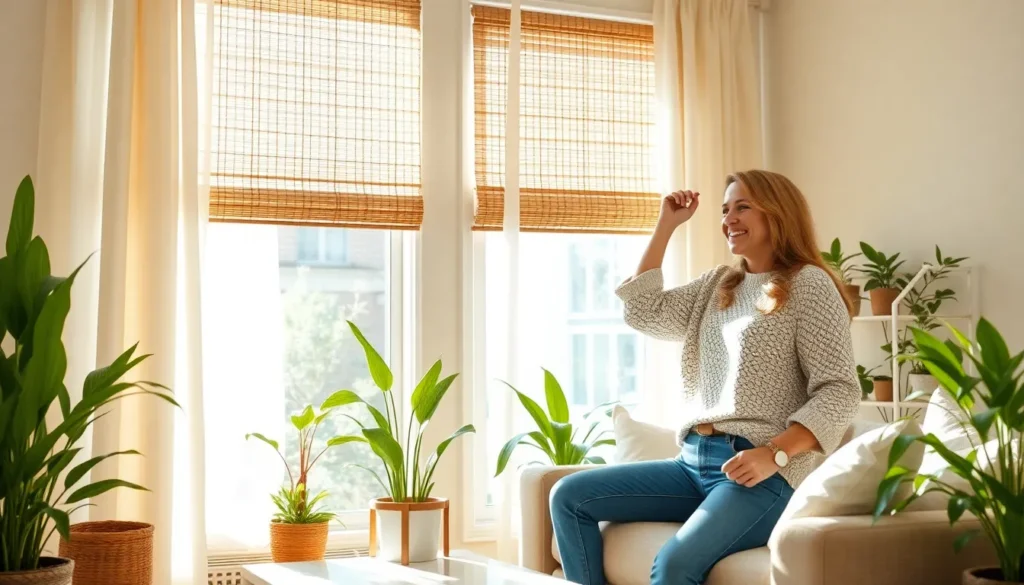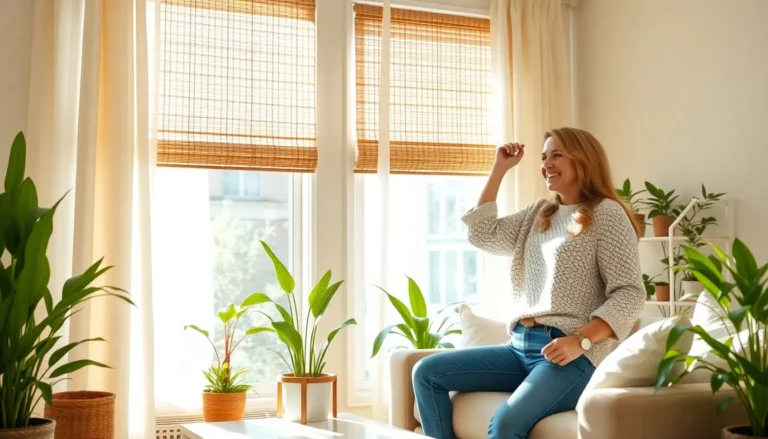When it comes to sprucing up a home, window dressings often get the short end of the stick. After all, who knew curtains could have a personality crisis? But fear not! Eco-friendly window dressings are here to save the day, proving that style and sustainability can coexist without a hitch.
Table of Contents
ToggleOverview of Eco-Friendly Window Dressings
Eco-friendly window dressings offer both style and sustainability, making them an ideal choice for conscious homeowners. Many options utilize natural materials such as organic cotton, bamboo, or linen, providing durable alternatives to traditional synthetic fabrics. These materials often undergo minimal processing, reducing their environmental impact during production.
Sustainable window dressings come in various forms, including curtains, blinds, and shades. Curtain choices can range from sheer organic cotton to heavier options insulated for energy efficiency. Bamboo shades provide a unique aesthetic while offering excellent light control and temperature regulation.
Window treatments made from recycled materials also contribute to eco-friendliness. Some manufacturers design products from reclaimed textiles or repurposed materials, significantly decreasing landfill contributions. By selecting these options, consumers support the circular economy and reduce waste.
Furthermore, many eco-friendly dressings feature low-impact dyes, minimizing chemical use during production. Some brands prioritize non-toxic finishes, ensuring that indoor air quality remains high. Shopping from environmentally-conscious companies also fosters responsible business practices in the industry.
Installing eco-friendly window dressings can lead to energy savings over time. Improved insulation helps maintain temperatures, reducing reliance on heating and cooling systems. This benefit translates into lower energy bills and a smaller carbon footprint.
Consideration of local sourcing enhances the sustainability aspect. Purchasing from nearby producers decreases transportation emissions while supporting the local economy. Making informed choices about materials, production methods, and sourcing strengthens the overall ecological benefits of window dressings.
Benefits of Eco-Friendly Window Dressings
Eco-friendly window dressings offer numerous advantages that contribute to sustainable living and improved home environments.
Energy Efficiency
Eco-friendly window dressings enhance energy efficiency by providing better insulation. Insulated curtains can significantly reduce heat loss in cold months and minimize heat gain during the summer. This efficiency leads to decreased reliance on heating and cooling systems, which lowers energy bills. Research indicates that insulated window treatments can reduce energy consumption by up to 25%. Bamboo blinds or shades also absorb heat, creating a comfortable indoor climate. Homeowners benefit from these energy-saving qualities through lower utility costs and a reduced carbon footprint.
Healthier Indoor Air Quality
Healthier indoor air quality becomes attainable with eco-friendly window dressings. Many of these products utilize low-impact dyes and non-toxic finishes that do not release harmful chemicals into the home. Organic materials like cotton and linen are naturally breathable, allowing for better air circulation. Improved air quality results in reduced allergens such as dust and mold, creating a healthier living environment. Additionally, non-toxic options help prevent headaches and other health issues commonly associated with synthetic materials. Thus, eco-friendly window treatments offer significant health benefits alongside their aesthetic appeal.
Types of Eco-Friendly Window Dressings
Eco-friendly window dressings incorporate sustainable practices and promote a healthier home environment. Various options exist, catering to both aesthetic preferences and ecological considerations.
Sustainable Materials
Natural materials define the sustainable window dressing landscape. Organic cotton offers a soft texture and breathability, ensuring comfort while minimizing environmental impact. Bamboo stands out with its rapid growth and durability, providing both style and function. Linen presents a sophisticated look, often sourced from local producers, which reduces transportation emissions. These materials not only enhance aesthetics but also support sustainable harvesting practices, creating an eco-friendly atmosphere within living spaces.
Recyclable and Biodegradable Options
Recyclable and biodegradable window dressings play a significant role in reducing waste. Products made from recycled polyester can often be repurposed and prevent further landfill accumulation. Biodegradable fabrics, such as those made from hemp and organic cotton, break down naturally over time, leaving minimal ecological impact. Additionally, these options contribute to the circular economy by utilizing post-consumer materials, reinforcing sustainability while offering diverse design choices. Homeowners can enhance their interior design while embracing eco-conscious decisions through these innovative selections.
Tips for Choosing Eco-Friendly Window Dressings
Selecting the right eco-friendly window dressings involves understanding specific needs and aligning them with aesthetic preferences and functionality.
Assessing Your Needs
Identify the primary purpose of window dressings. Consider factors like light control, privacy, and energy efficiency. Evaluate the room’s exposure to sunlight; south-facing rooms might require heavier materials for better insulation. Think about maintenance requirements too; some materials might need frequent cleaning. Determine if there’s a need for blackout options in bedrooms or sheer fabrics in living areas. Establish how important eco-conscious materials are for personal values, as sourcing and sustainability can influence choices significantly.
Considering Aesthetics and Functionality
Explore various styles that complement existing decor. Consider color schemes and patterns that enhance the overall aesthetic appeal. Match materials like organic cotton and bamboo with the desired ambiance; lighter colors can brighten a room while darker shades provide sophistication. Evaluate the functionality of different styles; roller shades offer a modern appearance while drapery adds elegance. Find a balance between style and practical benefits like insulation and heat regulation. Prioritize flexibility, as adjustable window dressings can adapt to changing circumstances.
Conclusion
Choosing eco-friendly window dressings not only enhances the beauty of a home but also aligns with sustainable living practices. By opting for materials like organic cotton and bamboo, homeowners can enjoy stylish and functional designs that promote better indoor air quality and energy efficiency.
These window treatments offer a perfect blend of aesthetics and environmental responsibility. Local sourcing and the use of recycled materials further amplify their positive impact on both the planet and local economies.
Making informed choices about window dressings is a step toward creating a healthier living space while contributing to a more sustainable future. Embracing eco-friendly options allows individuals to express their personal style without sacrificing their commitment to the environment.











